
Marine Fighter Attack Squadron 312 (VMFA-312) is a United States Marine Corps F/A-18C Hornet squadron. Also known as the "Checkerboards", the squadron is based at Marine Corps Air Station Beaufort, South Carolina and falls under the command of Marine Aircraft Group 31 (MAG-31) and the 2nd Marine Aircraft Wing. The Radio Callsign is "Check."

Marine Fighting Squadron 313 (VMF-313) was a reserve fighter squadron in the United States Marine Corps. They were a part of the 4th Marine Aircraft Wing and stationed at Naval Air Station New York. Also known as the “Lily Packin' Hellbirds” and the "Lilly Packin' Death Falcons", they fought in World War II mainly during the Philippines Campaign, 1944-45. The squadron was decommissioned in the 1950s.

Marine Fighter Attack Squadron 351 (VMFA-351) was a fighter squadron in the Marine Forces Reserve. The squadron was based at Naval Air Station Atlanta and participated in action during World War II and was decommissioned in 1975.
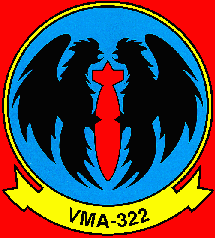
Marine Attack Squadron 322 (VMA-322) was an attack squadron in the United States Marine Corps. The squadron, also known as the “Fighting Gamecocks”, fought in World War II and later became a part of the Marine Forces Reserve based out of Naval Air Station South Weymouth, Massachusetts.
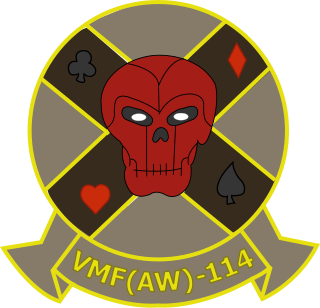
Marine All-Weather Fighter Squadron 114 was a squadron of the United States Marine Corps that was originally commissioned during World War II. Nicknamed the “Death Dealers”, the squadron saw the most action during the war providing close air support during the Battle of Peleliu. The squadron remained on active duty until being decommissioned in 1963.

Marine Fighter Squadron 123 (VMF-123) was a fighter squadron of the United States Marine Corps during World War II and later in the Marine Forces Reserve. Known as the “Flying Eight Balls,” the squadron fought at Guadalcanal, Iwo Jima, and Okinawa and served as a training squadron for replacement pilots during the Korean War. The squadron was decommissioned on October 31, 1965 at Naval Air Station Los Alamitos.
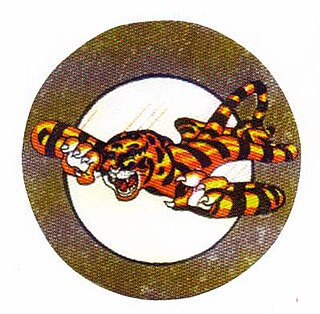
Marine Fighter Squadron 911 (VMF-911) was an aircraft squadron of the United States Marine Corps during World War II. Known as the “Devilcats”, it served as a training squadron during the war, and was decommissioned in early 1946.
Marine Aircraft Group 53 (MAG-53) was a United States Marine Corps night fighter training group that was commissioned during World War II. It was the first night-fighter group in the Marine Corps. During the course of the war the group trained eight night fighting squadrons and sent seven of them into combat. The group was decommissioned after the war during the post-war drawdown of forces.

Marine Fighting Squadron 216 (VMF-216) was a reserve fighter squadron of the United States Marine Corps that was based out of Washington. Known as the “Bulldogs”, VMF-216 participated in numerous combat engagements in the Pacific Theater during World War II to include the Battle of Guam and the Battle of Iwo Jima. The squadron was decommissioned shortly after the end of the war but was reactivated in 1946 as part of the Marine Air Reserve. The squadron remained in the Reserve until being decommissioned on December 21, 1972.
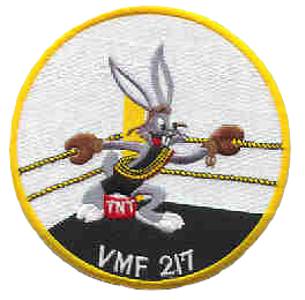
Marine Attack Squadron 217 (VMA-217) was a fighter squadron of the United States Marine Corps that was activated and fought during World War II. Known as “Max’s Wild Hares”, they fought in many areas of the Pacific War including the Battle of Iwo Jima. Following the surrender of Japan, the squadron was deactivated on March 10, 1946. They were briefly reactivated as part of the Reserves but were again deactivated in 1964 and remain in an inactive status today.

Marine Fighting Squadron 215 (VMF-215) was a fighter squadron of the United States Marine Corps that was commissioned and fought during World War II. Known as "The Fighting Corsairs", the squadron fought in many areas of the Pacific War, including the Battle of Bougainville. During its four-and-a-half month tour, the squadron was credited with shooting down 137 enemy aircraft, fourth most in Marine Corps aviation history.

Marine Fighting Squadron 511 (VMF-511) was a fighter squadron of the Marine Corps and Marine Forces Reserve during World War II and the Cold War which flew aircraft types such as the F6F Hellcat, F4U Corsair, and the F-8 Crusader. They were originally activated during World War II and fought during the Battle of Okinawa and the Battle of Balikpapan (1945). They specialized in close air support and during the course of the war were credited with only one plane shot down.
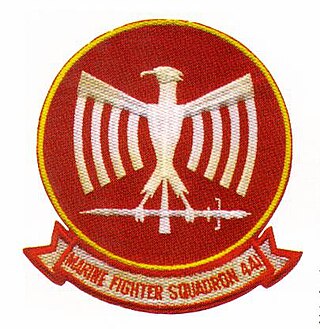
Marine Fighting Squadron 441 (VMF-441) was a fighter squadron of the Marine Forces Reserve during the Cold War. Originally commissioned during World War II, the squadron fought during the Battle of Okinawa. Nicknamed "The Blackjacks", VMF-441 was credited with 49 planes shot during the course of the war. Following the surrender of Japan, the squadron was decommissioned on July 11, 1946. They were reactivated in the Marine Air Reserve and were based out of Naval Air Station Niagara Falls, New York.
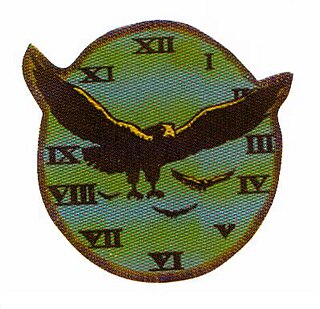
Marine Attack Squadron 543 (VMA-543) was an aviation unit of the United States Marine Corps. The squadron, also known as the “Night Hawks”, were part of the Marine Forces Reserve and were based at Naval Air Station Glenview, Illinois until their deactivation on April 1, 1974. Originally activated during World War II, they fought in the Battle of Okinawa as part of the Tactical Air Force. The squadron was credited with downing 15 Japanese aircraft during the war. Following the surrender of Japan, the squadron was deactivated only to be later reactivated as part of the Reserves. They were again deactivated in 1974 and remain in an inactive status today.
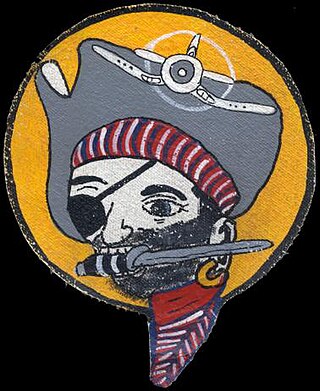
Marine Fighting Squadron 512 (VMF-512) was a fighter squadron of the United States Marine Corps during World War II. The squadron was aircraft carrier based during the last year of the war and supported combat operations during the Battle of Okinawa and the Battle of Balikpapan (1945). Following the end of World War II they were deactivated on 10 March 1946 and remain in an inactive status today.

Marine Fighter Squadron 541 (VMF-541) was a reserve fighter squadron of the United States Marine Corps. Originally commissioned during World War II as a night fighter unit flying the F6F-5N Hellcat, the squadron participated in combat action over Peleliu and while supporting the liberation of the Philippines in 1944–45. During the war, VMF(N)-541 was credited with downing 23 Japanese aircraft. Following the war, the squadron participated in the occupation of Northern China until returning to the States to be decommissioned on April 20, 1946. The squadron was reactivated sometime after the war in the Marine Corps Reserve until being decommissioned again in the early 1960s.
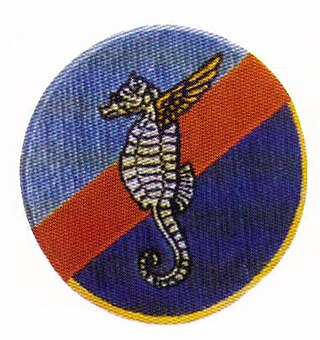
Marine Fighting Squadron 472 (VMF-472) was a fighter squadron of the United States Marine Corps during World War II. Known as “The Flying Seahorses”, the squadron flew the Grumman F6F Hellcat during its short time in existence. The squadron was slated to support the invasion of Japan in late 1945 however the Japanese surrender meant it did not get further than Hawaii and did not participate in combat action during the war. VMF-472 was decommissioned on December 24, 1945 and no other Marine Corps squadron has carried its lineage and honors since.

Marine Night Fighter Squadron 532 was a United States Marine Corps night fighter squadron that was commissioned during World War II. The squadron, which flew the F4U-2 Corsair, was the second night fighter squadron commissioned by the Marine Corps, the first to fly a single-seat, radar-equipped night fighter, and the only Marine squadron to fly the F4U-2 in combat. VMF(N)-532 saw extensive combat operations throughout 1944 in support of Marine Corps operations at Kwajalein Atoll and the Mariana Islands. The squadron was decommissioned on May 31, 1947, as part of the post-war draw down of the service. Since then, no other Marine Corps squadron has carried the lineage and honors of VMF(N)-532.
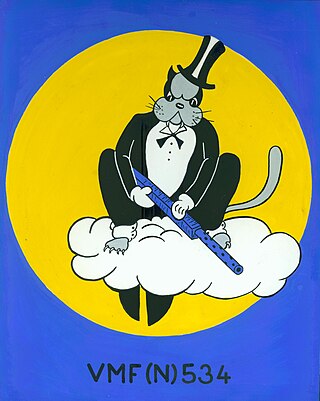
Marine Night Fighter Squadron 534 was a United States Marine Corps night fighter squadron that was commissioned during World War II. It was the fourth night fighter squadron commissioned in the service and participated in limited combat operations throughout 1944 and 1945 during Marine Corps operations over Kwajalein Atoll and the Mariana Islands. The squadron was decommissioned on May 31, 1947, as part of the post-war draw down of the service. Since then, no other Marine Corps squadron has carried the lineage and honors of VMF(N)-534.



















